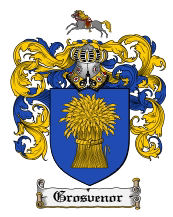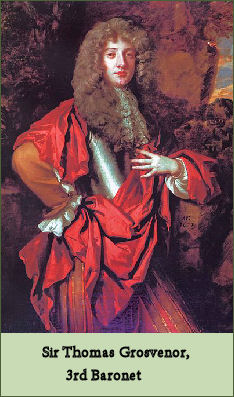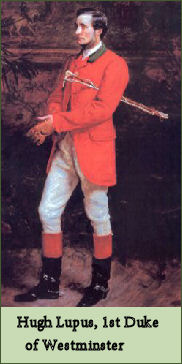The Grosvenor Family- Dukes of Westminster

 The Grosvenor family of Eaton Hall in Cheshire descend from Gilbert le Grosveneur, (the name means chief huntsman in Norman French) a relative of King William the Conqueror, who came over to England from Normandy with him in 1066, accompanied by Gilbert’s uncle, Hugh Lupus D’Avranches, who was later created Earl of Chester.
The Grosvenor family of Eaton Hall in Cheshire descend from Gilbert le Grosveneur, (the name means chief huntsman in Norman French) a relative of King William the Conqueror, who came over to England from Normandy with him in 1066, accompanied by Gilbert’s uncle, Hugh Lupus D’Avranches, who was later created Earl of Chester.
The family inherited Eaton Hall in Cheshire through the marriage of Raufe Grosvenor of Hulme to Joan, heiress of the Eaton estate in 1443.
They acquired their considerable fortune through mines and minerals in North Wales and through the later development of property in London's Mayfair and Belgravia. Through the marriage of Mary Davies and Sir Thomas Grosvenor (pictured right) in 1677, the Grosvenor's inherited 500 acres of land north of the Thames to the west of London.
The Grosvenor family rose from knightly status through the peerage when Sir Richard Grosvenor (1584-1645), son of Richard Grosvenor of Eaton, and Christian, the daughter of Sir Richard Brooke of Norton Priory, Cheshire, was created first baronet by King James I, in 1622. Sir Richard found himself consigned to a debtor's cell after guaranteeing loans which went unpaid by his spendthrift brother-in-law. A member of Parliament for Cheshire, Richard Grosvenor's diary-taking has been described as meticulous and it is thought his diary taking represents some of the most complete accounts of Parliamentary debate from the period. His son and heir, Sir Richard Grosvenor, 2nd Baronet, fought on the Royalist side during the Civil War.
 Richard Grosvenor, Baronet and Lord Grosvenor (18 June 1731 – 5 August 1802) was created Viscount Belgrave and 1st Earl Grosvenor in 1784. A racehorse owner and art collector, for his art collection he acquired works from Italy, and also bought paintings from Benjamin West (including his painting of The Death of General Wolfe), Thomas Gainsborough, Richard Wilson and George Stubbs.
Richard Grosvenor, Baronet and Lord Grosvenor (18 June 1731 – 5 August 1802) was created Viscount Belgrave and 1st Earl Grosvenor in 1784. A racehorse owner and art collector, for his art collection he acquired works from Italy, and also bought paintings from Benjamin West (including his painting of The Death of General Wolfe), Thomas Gainsborough, Richard Wilson and George Stubbs.
His son, Robert Grosvenor, (22 March 1767 – 17 February 1845) was created Marquess of Westminster in 1831. Soon after Robert Grosvenor inherited the Eaton estate, he rebuilt the country house at Eaton Hall in Cheshire, and he also developed the London estate, creating the areas now known as Belgravia and Pimlico. Robert added to the family art collection, his acquisitions included four paintings by Rubens for which he paid £10,000, and he paid £100 for Gainsborough's The Blue Boy.
Robert's grandson, Hugh Lupus Grosvenor (1825- 1899) became the first Duke of Westminster in 1874. He built the magnificent victorian hall at Eaton as well as Eaton Chapel and the handsome courtyard which still survives today.
He developed the stud at Eaton Hall and achieved success in racing his horses, winning the Derby on four occasions. Hugh Grosvenor also took an interest in a range of charities. At his death he was considered to be the richest man in Britain. Hugh Grosvenor was succeeded as Duke of Westminster by his grandson, Hugh, the son of Victor Grosvenor, Earl Grosvenor, and Lady Sibell Lumley, the daughter of the 9th Earl of Scarborough.
The present Duke of Westminster is Gerald Cavendish Grosvenor, listed as the world's 46th richest person by Forbes magazine. The sixth Duke is the son of Robert George Grosvenor, 5th Duke of Westminster, and his wife Hon. Viola Maud Lyttelton.
The family seat of Eaton Hall is set within a large estate 1 mile (2 km) south of the village of Eccleston, in Cheshire, (grid reference SJ413607). The house is surrounded by formal gardens, parkland, farmland and woodland. The gardens at Eaton Hall draw thousands of visitors each year. The gardens are only open to the public three times a year to raise funds for charity.
Back to Cheshire and Derbyshire history menu
